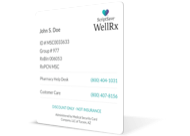Copyright 2024
Medical Security Card Company, LLC
All Rights Reserved
WellRx will never sell your personal information. Period. By signing up I agree to WellRx's terms of use and privacy policy.
Jordan Stachel, MA, RDN
February 15, 2022
You may have heard of simple and complex carbohydrates, but figuring out what sugars are in your food can be anything but simple. Read on to learn more.
Sugar is a simple carbohydrate broken down efficiently by the body and is found in two different formats in foods: natural sugars and added sugars.
Here are seven common foods with sneaky sources of added sugar.
Granola is a delicious food item with many different varieties and flavors. In granola, sugar sources vary but often come as a combination of cane sugar, honey, and/or maple syrup.
To determine where the added sugars are derived, check the ingredient list. To keep sugar portions within reason, try to aim for granola options with 10 grams of sugar or less per serving as a good rule of thumb.
Yogurt is a food packed with nutrition, and it comes in several different varieties.
Depending on the percentage of milkfat in the yogurt, the natural sugar level will vary (if only slightly). For example, if you consume Greek whole milk yogurt, 7 ounces of yogurt has about 6 grams of naturally occurring sugar. Compare this with 7 ounces of non-fat Greek yogurt, which has about 5 grams of naturally occurring sugars. As you can see, the difference in sugar content made naturally by lactose remains minor.
But if you begin to compare flavored varieties of yogurt, you’ll start to see where the hidden sugar sources lie. In a fruit-flavored Greek yogurt variety, the same 7-ounce serving has around 11 grams of sugar, with 7 grams being added sugar. When possible, choose unsweetened forms of yogurt and add your own fruit topping to it, if desired.
Energy bars, or protein bars, are a vast market. Options vary widely in overall nutritional and sugar content. Often, protein bars are more like candy bars if comparing sugar content to sugar content. For example, a Snickers bar has 28 grams of sugar, with 26 grams coming from added sugars. Several energy bars on the market have equally high sugar content.
While the sugar from an energy bar may be derived from honey, maple syrup, or fruit, it still gets metabolized in the body as sugar. When looking for energy bars, choose those higher in fiber and protein and lower in overall sugar to watch your sugar intake. Watching your sugar intake is vital, as it is protective against diseases like metabolic syndrome.
Pre-made smoothie mixes or bowls that you may order from a cafe can be extremely high in added sugars, depending on what constitutes the mix. A fruit-based smoothie contains natural sugars from fruit and may have any number of added sugars. These can include sweeteners like honey, maple syrup, or chocolate syrups. If the smoothie is served as a “bowl,” toppings typically include added sugars, honey, granola, chocolate chips, or sweetened coconut.
Coffee creamers may include sneaky sugar sources, usually in the format of cane sugar or syrups. For example, a vanilla coffee creamer contains around 5 grams of added sugar per tablespoon. This can add up quickly if you aren’t careful how much creamer you add to your morning coffee. You may find you’re already starting your day with upwards of 10-15 grams of added sugars.
While there are plenty of cereals to choose from on the market, not all are created equal from an added sugar perspective. One cup of Lucky Charms contains around 12 grams of added sugar. In comparison, one cup of Cheerios contains about 1 gram of added sugar. That’s a big difference!
If choosing a sugary cereal, be more mindful of portion intake to help keep overall sugar intake within reason.
With many people choosing to consume more plant-based products in general, the non-dairy milk space has exploded, with many options. Some non-dairy alternatives can be incredibly high in sugar when considering added sugars. For example, 1 cup of original flavored almond milk contains 7 grams of added sugar, whereas the unsweetened alternative includes 0 grams of added sugar. When possible, choose the unsweetened versions of your favorite non-dairy alternative for a lower sugar option.
Overall, added sugars are present in many foods, and consumers must monitor how many added sugars they are eating daily. When in doubt, check the nutrition label and the ingredient list to see where sugars are derived and how much added sugar is in each serving. It’s worth the extra time at the supermarket to choose more moderate items in sugar content, when possible.
For personalized lower-sugar nutrition recommendations, check out the free ScriptSave WellRx app today. We make it easy to find better-for-you foods and detailed nutrition information at the grocery store.
Jordan Stachel holds a Master’s degree in Nutrition and Dietetics from The University of Southern California and is a Registered Dietitian Nutritionist. She has several years of experience helping clients reach their health goals through her clinical work within private practice. Jordan is most fulfilled when guiding others towards making stepwise, sustainable changes that add up to big results over time. Jordan works with a wide variety of individuals, ranging in age from children through the elderly, with an assortment of concerns and clinical conditions. She helps individuals optimize overall health and/or manage disease states using personalized medical nutrition therapy techniques.
Resources:
https://www.sugar.org/sugar/what-is-sugar/
https://www.heart.org/en/healthy-living/healthy-eating/eat-smart/sugar/sugar-101
https://www.mayoclinic.org/drugs-supplements-honey/art-20363819

For your convenience, use the ScriptSave® WellRx mobile app. Now savings are well in hand, right at the pharmacy counter. Save on your family's prescription medicines.
Learn More
Your choice. Get a ScriptSave WellRx Savings Card. Or Download the free mobile app from the App Store or Google Play Store
Get A Card
ScriptSave WellRx Grocery Guidance leverages leading-edge nutritional data science to help you know which food products on your grocery store shelf are truly good for YOU.
Healthy Foods For YouTags:

November 07, 2024

October 23, 2024

May 07, 2024
You need to log into the site to use this feature
This feature requires registration. Sign up or log in to your free WellRx account to gain access to this and other tools to help make managing your medications and wellness easier.
Benefits Include:
 Store & manage your medication list
Store & manage your medication list
 Medication pricing updates
Medication pricing updates
 Medication information
Medication information
 Pill & refill reminders
Pill & refill reminders
 Medication journal & mood log
Medication journal & mood log
This feature requires registration. Sign up or log in to your free WellRx account to gain access to this and other tools to help make managing your medications and wellness easier.
Benefits Include:
 Store & manage your medication list
Store & manage your medication list
 Medication pricing updates
Medication pricing updates
 Medication information
Medication information
 Pill & refill reminders
Pill & refill reminders
 Medication journal & mood log
Medication journal & mood log
You will be redirected to your program in 5 seconds.
Our Terms and Conditions and Privacy Policy have recently been updated.
By declining you will be logged out of your account